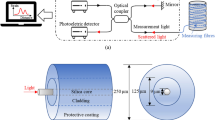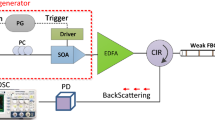Abstract
The uniaxial compressive strength (UCS) test is crucial in determining the strength and stiffness behavior of intact rock and is frequently utilized by industry to determine project site characteristics. A fundamental procedure of UCS testing is strain response measurement. Conventionally, discrete strain measuring devices such as extensometers and/or electric foil strain gauges are used to measure the strain response at the mid-height of a specimen. However, this ultimately limits the ability to capture full-field strain of UCS test specimens. This has led to a gap in knowledge in terms of the complexities of UCS test strain responses caused by factors such as specimen heterogeneity and the influence of platen friction. Within this context, a novel distributed optical strain sensing (DOS) technology has been integrated with UCS testing (DOS-UCS technique). Unlike conventional discrete strain measurement methods, the optical technique captures a distributed strain profile along the length of standard, low-cost single mode optical fiber with a spatial sampling resolution of 0.65 mm. By wrapping an optical strain sensor around a UCS specimen, continuous full-field strain profiles along the length and circumference of UCS specimens can be realized. This paper presents a laboratory investigation that illustrates the potential of this technology to provide an in-depth look into the strain response of heterogeneous nodular limestone during UCS testing.
















Similar content being viewed by others
References
Abdulqader A, Rizos DC (2020) Advantages of using digital image correlation techniques in uniaxial compression tests. Results Eng 6:100109
Alejano LR, Arzua J, Castro-Filqueira U, Malan F (2017) Strapping of pillars with cables to enhance pillar stability. J South Afr Inst Min Metall 117:527–540. https://doi.org/10.17159/2411-9717
ASTM (2014) Designation D7012-14: standard test methods for compressive strength and elastic moduli of intact rock core specimens under varying states of stress and temperatures. ASTM International, West Conshohocken. https://doi.org/10.1520/D7012-1
ASTM (2019) Designation D4543-19: standard practices for preparing rock core as cylindrical test specimens and verifying conformance to dimensional and shape tolerances. ASTM International, West Conshohocken. https://doi.org/10.1520/D4543-19
Benzaid R, Mesbah HA (2013) Circular and square concrete columns externally confined by CFRP composite: experimental investigation and effective strength models. In: Fiber reinforced polymers—the technology applied for concrete repair. INTECH, pp 167–201 (ISBN: 978-953-51-0938-9)
Bieniawski ZT, Bernede MJ (1979) Suggested methods for determining the uniaxial compressive strength and deformability of rock materials. Int J Rock Mech Min Sci Geomech Abstr 16(2):138–140. https://doi.org/10.1016/0148-9062(79)91451-7
Brookfield ME, Brett CE (1988) Paleoenvironments of the Mid-Ordovician (Upper Caradocian) Trenton limestones of southern Ontario, Canada: storm sedimentation on a shoal-basin shelf model. Sed Geol 57:75–105
Corning (2014) ClearCurve ZBL optical fiber product information [Datasheet]. Corning Incorporated, New York
Forbes B (2015) The application of distributed optical sensing for monitoring support in underground excavations. Dissertation at Queen’s University
Forbes B, Vlachopoulos N, Hyett AJ (2018) The application of distributed optical strain sensing to measure the strain distribution of ground support members. FACETS 3(1):195–226. https://doi.org/10.1139/facets-2017-0093
Frizzell R, Cotesta L, Usher S (2008) Phase I Regional Geology, Southern Ontario (OPG 00216-REP-01300-00007-R00), Toronto
Froggatt M, Moore J (1998) High-spatial-resolution distributed strain measurement in optical fiber with Rayleigh scatter. Appl Opt 37(10):1735–1740
Hegger S, Diederichs MS, Vlachopoulos N, Forbes B (2020) Laboratory investigation of distributed fiber optic strain sensing to measure strain distribution of rock samples. In: Proceedings of the ISRM international symposium, Eurock ’20
Luna Innovation Inc (2017) ODiSI-B optical distributed sensor interrogator data sheet. Luna Innovation Inc., Blacksburg
Peng S, Johnson AM (1972) Crack growth and faulting in cylindrical specimens of Chelmsford granite. Int J Rock Mech Mineral Sci 9:37–86
Peters W, Ranson W (1982) Digital imaging techniques in experimental stress analysis. Opt Eng 21(3):427–431
Rechenmacher A, Finno R (2004) Digital image correlation to evaluate shear banding in dilative sands. Geotech Test J 27(1):13–22. https://doi.org/10.1520/GTJ11263J
Regier RR (2013) Applications of fiber optics on reinforced concrete structures to develop a structural health monitoring technique. Dissertation at Queen’s University
Schmidt-Hattenberger C, Naumann M, Günter B (2003) Fiber Bragg grating strain measurements in comparison with additional techniques for rock mechanical testing. IEEE Sens J 3(1):50–55
Sun Y, Li Q, Yang D, Fan C, Sun A (2016) Investigation of the dynamic strain responses of sandstone using multichannel fiber-optic sensor arrays. Eng Geol 213:1–10
Sutton M, Wolters W, Peters W, Ranson W, McNeill S (1983) Determination of displacements using an improved digital correlation method. Image vis Comput 1(3):133–139
Take W (2015) Thirty-sixth Canadian geotechnical colloquium: advances in visualization of geotechnical processes through digital image correlation. Can Geotech J 52(9):1199–1220. https://doi.org/10.1139/cgj-2014-0080
Vlachopoulos N, Cruz D, Forbes B (2018) Utilizing a novel fiber optic technology to capture the axial response of fully grouted rock bolts. J Rock Mech Geotech Eng 10(2):222–235
Weisbrich M, Holschemacher K (2018) Comparison between different fiber coatings and adhesives on steel surfaces for distributed optical strain measurements based on Rayleigh backscattering. J Sens Sens Syst. https://doi.org/10.5194/jsss-7-601-2018
White D, Take W, Bolton M (2003) Soil deformation measurement using particle image velocimetry (PIV) and photogrammetry. Geotechnique 53(7):619–631. https://doi.org/10.1680/geot.2003.53.7.619
Acknowledgements
The Natural Sciences and Engineering Research Council of Canada (NSERC), Nuclear Waste Management Organization (NWMO), and Canadian Department of National Defence (DND) have financially supported this research. Equipment and instrumentation support were provided by the RMC Green Team.
Author information
Authors and Affiliations
Corresponding author
Additional information
Publisher's Note
Springer Nature remains neutral with regard to jurisdictional claims in published maps and institutional affiliations.
Rights and permissions
About this article
Cite this article
Hegger, S., Vlachopoulos, N., Poles, T. et al. Measuring the Full-Field Strain Response of Uniaxial Compression Test Specimens Using Distributed Fiber Optic Sensing. Rock Mech Rock Eng 55, 2615–2630 (2022). https://doi.org/10.1007/s00603-021-02643-4
Received:
Accepted:
Published:
Issue Date:
DOI: https://doi.org/10.1007/s00603-021-02643-4




